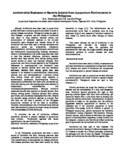Antimicrobial resistance in bacteria isolated from aquaculture environments in the Philippines
- Global styles
- MLA
- Vancouver
- Elsevier - Harvard
- APA
- Help
Share
นามธรรม
Antibiotics have been used in aquaculture as feed additives to promote growth and added in water to prevent disease occurrence. Therapeutic doses are used to treat diseases. Long-term use and misuse of antibiotics may result to drug resistant bacterial strains and accumulation of unwanted residues in the cultured commodity upon slaughter and harvest. Some of the antibiotics that have been used in shrimp hatcheries and grow-out ponds are tetracycline, rifampicin, chloramphenicol, nitrofurans, erythromycin, oxolinic acid and furazolidone. Oxytetracycline, furanace, terramycin, Ektecin, chloramphenicol and sulfa drugs have been used to treat fish bacterial infections. Antibiotic resistant bacteria have been isolated from shrimp rearing water, natural bodies of water that received effluents from aquaculture, and from cultured apecies in the Philippines. Resistance to oxytetracycline and furaltadon were reported in bacteria isolated from crab and nearshore sediments. Bacteria from shrimp ponds have been reported to be resistant to oxytetracycline, furazolidone, oxolinic acid and chloramphenicol. Luminous vibrios from shrimp larvae and ponds were resistant to erythromycin, kanamycin, oxytetracycline, Penicillin, streptomycin, sulfadiazine and triple sulfa. Aeromonas sp. from fish, shrimp, and their rearing water were resistant to streptomycin, oxytetracycline and trimethoprim/sulphamethoxazole. Multiple antibiotic resistance has also been reported in bacteria isolated from shrimp, shrimp ponds, luminous bacteria from shrimp post larvae, and Aeromonas hydrophila from fish. Despite the recorded usage, antibiotic residues in cultured food fish have not yet been a problem of the Philippine aquaculture industry as far as trade is concerned. However, chloramphenicol and nitrofurazolidone residues have been detected in shrimp for export using the enzyme link immunoassay (ELISA) technique.
To minimize the use of antibiotics, different alternative methods to prevent diseases in aquaculture have evolved. Government agencies also issued regulations on the use of antibiotics.
การอ้างอิง
Tendencia, E. A., & Lavilla-Pitogo, C. R. (2005). Antimicrobial resistance in bacteria isolated from aquaculture environments in the Philippines. In Proceedings of the International Workshop: Antibiotic Resistance in Aquaculture Environments, 24-25 February 2005, Chiang Mai, Thailand (Track 1_4). Chiang Mai, Thailand: ASIARESIST.
Type
Conference paperISBN
8890134437คอลเลกชัน
- Conference Proceedings [299]



